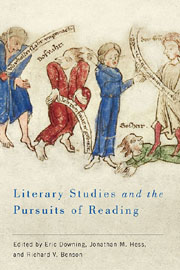Book contents
- Frontmatter
- Contents
- List of Illustrations
- Introduction
- Part I Medieval and Early Modern Practices of Reading
- Part II Reading, Secularization, and Transcendence in the Long Nineteenth Century
- 5 Reading and the Writing of German-Jewish History
- 6 Similia Similibus Curentur: Homeopathy and Its Magic Wand of Analogy
- 7 Reading and Rhetorical Generation: The Example of Blake's Thel
- 8 Sender Glatteis Reads Lessing and Comes to a Sad End: Some Thoughts on Karl Emil Franzos's Der Pojaz and the Problem of Jewish Reading
- Part III Theories and Practices of Reading in the Twentieth Century and Beyond
- Part IV Postscript: The Ends of Reading
- Works Cited
- Notes on the Contributors
- Index
7 - Reading and Rhetorical Generation: The Example of Blake's Thel
from Part II - Reading, Secularization, and Transcendence in the Long Nineteenth Century
Published online by Cambridge University Press: 05 February 2013
- Frontmatter
- Contents
- List of Illustrations
- Introduction
- Part I Medieval and Early Modern Practices of Reading
- Part II Reading, Secularization, and Transcendence in the Long Nineteenth Century
- 5 Reading and the Writing of German-Jewish History
- 6 Similia Similibus Curentur: Homeopathy and Its Magic Wand of Analogy
- 7 Reading and Rhetorical Generation: The Example of Blake's Thel
- 8 Sender Glatteis Reads Lessing and Comes to a Sad End: Some Thoughts on Karl Emil Franzos's Der Pojaz and the Problem of Jewish Reading
- Part III Theories and Practices of Reading in the Twentieth Century and Beyond
- Part IV Postscript: The Ends of Reading
- Works Cited
- Notes on the Contributors
- Index
Summary
I call them by their English names: English. the rough basement, Los built the stubborn structure of the Language. acting against Albions melancholy, who must else have been a Dumb despair.
—Blake, JerusalemThe theory of reading, as it is generally understood, concerns itself with procedures and problems associated with the interpretation of texts; reading is therefore studied primarily under the rubric of reception. One exception is the work of Clayton Koelb, which focuses steadily on reading as a productive, generative practice that can be investigated under the rubric of invention. Of course, understanding how a text comes into being greatly enhances the prospect of understanding how it can or ought to be performed; and thus the study of invention becomes a valuable aid in interpretation. Koelb's characteristic subject matter is therefore rhetorical construction in two interrelated senses: construction as the author's generation of structure, and construction as the reader's construal of meaning.
Although reading practices always manifest themselves in particular, historically determined forms, the theoretical issue of reading—the fundamental question of how human artifacts acquire and convey meaning—confronts every culture regardless of period, language, gender, ethnicity, or economic condition. For this reason, Koelb's conception of reading as an inventive practice turns out to be useful in studying texts from many different traditions, including some that fall outside his particular areas of expertise. This essay applies Koelb's ideas to a composite work of verbal and visual expression in a way not touched upon in his writing so far.
- Type
- Chapter
- Information
- Literary Studies and the Pursuits of Reading , pp. 148 - 167Publisher: Boydell & BrewerPrint publication year: 2012

